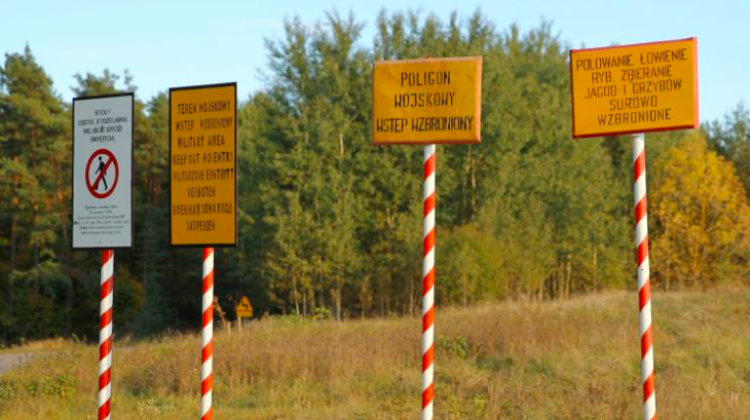Researchers from the Military University of Technology have developed a method for producing a thermobaric explosive
 Orzysz, 02.10.2014. No entry signs at the training area. PAP/Tomasz Waszczuk (tw/mgut)
Orzysz, 02.10.2014. No entry signs at the training area. PAP/Tomasz Waszczuk (tw/mgut)
Researchers at the Military University of Technology have developed a method for producing a thermobaric explosive. The material can be used for the production of modern weapons, including hand grenades and grenades for grenade launchers. This type of ammunition is currently not manufactured in Poland.
Researchers from the Faculty of Advanced Technologies and Chemistry of the Military University of Technology under the supervision of the dean of this faculty, Prof. Stanisław Cudziło developed a technology for the production of a thermobaric explosive. "This is a neglected area in our army. The Russians developed such explosives and warheads with this material already in the 1980s" - says Prof. Cudziło.
"This explosive is a mixture of classic explosives - TNT, hexogen or octogen - with metal powders. They are additional combustible agents" - explains Prof. Cudziło.
He explains that during the explosion of a thermobaric charge, metal powder burns in the post-explosion cloud using oxygen from the air. As a result, the energy release lasts longer, and the pressure and temperature in the vicinity of the centre of the explosion fall more slowly than in the case of a TNT explosion.
This means greater effectiveness against a live opponent, but also against fortifications or vehicles. The advantage of thermobaric material over a traditional one is also the fact that the oxygen needed to burn combustible components is taken from the atmosphere surrounding the explosion site, which means that the opponent can not breathe. These features significantly improve the efficiency of the weapon, which is why, for example, thermobaric materials are used in modern high-explosive or tandem warheads.
The Russians and the Americans use thermobaric materials on a large scale, but other modern armies also have armaments based on such charges. Thermobaric explosives are used to build huge aerial bombs. The Americans have created a bomb that carries nine tons of such material. They called it the "Mother of All Bombs". It is considered the largest conventional bomb in the world. The GBU-43 MOAB bomb was first used by the Americans in Afghanistan in 2017.
The Russians have a similar bomb dubbed the "Father of All Bombs". According to the Russians, it is supposed to be even stronger than the American one, although it contains only 7 tons of thermobaric material. The Russians used a thermobaric explosive mixture based on nanotechnology for its production. The effect of the explosion of such large thermobaric bombs is compared to nuclear weapons, although their strength is lower.
The Polish army does not plan such use of thermobaric charges, but the current Advanced Individual Combat System Titan includes plans to equip Polish soldiers with thermobaris grenades. At the present, initial stage of development of this weapon, the thermobaric material used for their construction is of foreign origin.
"Such a grenade thrown into a room full of people does not give a chance to defend against it with classical means of passive life protection, like bulletproof vests or other physical shields that can protect against a normal fragmentation grenade. In the case of a thermobaric grenade, the pressure in the room is so high that the opponent dies from the pressure, not from the shrapnel" - says Prof. Cudziło.
Explosive material developed by WAT scientists is suitable for small charges - including hand grenades and grenades for grenade launchers. "It is difficult to make a small thermobaric charge, it is much easier to make a large one because the parameters of the cloud are maintained longer. In a small cloud, the temperature drops sharply, and the ignited particles of metallic fuel are quickly extinguished" - he explains.
Cudziło does not reveal the composition of the material, but admits: "We have found a very good combustible additive, it has the advantage of reacting with carbon dioxide and water first in the expanding post-explosion cloud. Thanks to this, the flying particles are hot enough for their combustion to continue when atmospheric oxygen appears in the cloud".
He adds that the material consists of about 70 percent traditional explosive and 30 percent magnesium-based metal additive that provides a thermobaric effect. "After the explosion, our thermobaric additive +patiently waits+ for atmospheric oxygen to appear in the cloud and then it burns. The advantage is that the material can be produced with commercially available ingredients, so it will not be expensive to manufacture" - the scientist emphasizes.
A typical 1 kg thermobaric charge has a TNT equivalent of 1.6. That means it is 60 percent more effective than TNT alone. "We have irrefutable evidence that we have managed to achieve at least 2.0 equivalent in an even smaller, 200-gram charge. That means that if our material was used to build a grenade, its destruction radius would be twice as large as that of a grenade filled with TNT. Or that such a grenade would be twice as light, that is, easier to carry and use" - assures the expert.
Prof. Cudziło carried out tests of the thermobaric material in June this year at the training area in Nowa Dęba. The radius of dispersion of ammunition boxes filled with sand after detonation of this material was measured - it was twice as large as in the case of a TNT charge of the same mass. "There is a demand for a thermobaric ammunition, such as hand grenades, grenades for grenade launchers, but also for smoothbore guns on Polish combat vehicles" - the scientist says. (PAP)
author: Krzysztof Kowalczyk
krz/ zan/ pmw/ kap/
tr. RL
Przed dodaniem komentarza prosimy o zapoznanie z Regulaminem forum serwisu Nauka w Polsce.















